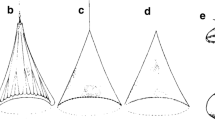Abstract
Two fishing castes, Ambiga and Harikantra, of Karnataka employ different techniques for throwing cast nets in the same habitat. Ambigas throw the net from above the head, as opposed to the far easier Harikantra method of throwing at the waist level. These different techniques are described here as memes, transmitted through learning. A logico- deductive hypothesis is developed here to explain the origin and maintenance of the memetic difference between the castes, with the help of circumstantial semiotic and anthropological evidence.
Similar content being viewed by others
References
Bandura, A. (1977).Social Learning Theory. Prentice-Hall, Engelwood Cliffs, NJ.
Béteilles, A. (1965).Caste, Class, and Power. University of California Press, Berkeley and Los Angeles.
Bhattacharyya, S. (1993). Ecological Organization of Indian Rural Populations. PhD dissertation, Indian Institute of Science, Bangalore.
Boyd, R., and Richerson, P. J. (1985).Culture and Evolutionary Process. Chicago University Press, Chicago.
Campbell, J. M. (1883).Gazettier of Bombay Presidency (Vol. XV, Pt. I). Kanare Government Central Press, Bombay, pp. 300–307.
Datta, B. N. (1944).Studies in Indian Social Polity. Purabi Publishers, Calcutta.
Dawkins, R. (1990).The Selfish Gene (2nd Ed.). Oxford University Press, London.
Gadgil, M., and Guha, R. (1992).This Fissured Land: An Ecological History of India. Oxford University Press, Delhi.
Gadgil, M., and Iyer, P. (1988). On the diversification of common property resource use by Indian society. In Berkes, F. (ed.),Common Property Resources: Ecology and Community-Based Sustainable Development. Belhaven, London, pp. 240–255.
Gadgil, M., and Malhotra, K. C. (1983). Adaptive significance of the Indian caste system: An ecological perspective.Human Ecology 10:465–478.
ISST (1986). Postscript toFisherwomen of Tadri: A Socio-Economic Survey. Institute of Social Studies Trust, Banagalore, pp. 6–7.
Klass, M. (1980).Caste: The Emergence of the South Asian Social System. Institute for the Study of Human Issues, Philadelphia.
Owens, R. L., and Nandy, A. (1977).The New Vaishyas. Allied Publishers, New Delhi.
Rappaport, R. A. (1971). The sacred in human evolution.Annual Review of Ecological Systems 2:23–44.
Thurston, E., and Rangachari, K. (1909).Castes and Tribes of Southern India (Vol. 1). Government Press, Madras.
Author information
Authors and Affiliations
Rights and permissions
About this article
Cite this article
Deb, D. Of cast net and caste identity: Memetic differentiation between two fishing communities of Karnataka. Hum Ecol 24, 109–123 (1996). https://doi.org/10.1007/BF02167963
Issue Date:
DOI: https://doi.org/10.1007/BF02167963




